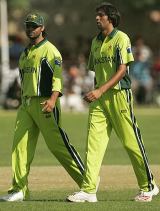Fast, furious, fragile
Pakistan's pace attack was meant to be its strength at the World Cup. Not anymore, with three fast bowlers expected to play key roles for Pakistan under various injury and drugs-related clouds
Cricinfo staff
13-Feb-2007
Pakistan's pace attack was meant to be its strength at the World Cup. Not anymore, with three fast bowlers expected to play key roles for Pakistan under various injury and drugs-related clouds. Hamstring, knee, elbow, ankle, groin: Cricinfo clears the air on who is suffering from what.
|
|

|
Doping
The Pakistan board (PCB) is conducting drugs tests on all players selected for the World Cup on February 17. Mohammad Asif and Shoaib Akhtar, who failed the last doping test in September, are also included in this.
Sports doping expert Danish Zaheer (a dissenting member of the appellate committee that overturned the bans on both last November) has already said that both are likely to test positive again. Not because of any new indiscretion, though, but because traces of Nandrolone, the banned anabolic steroid, are likely to remain in their bloodstream for some time after use. If they do test positive, it could have serious implications for the careers of both.
Rumours in Pakistan that the two have undergone private doping tests, confirming that levels of the banned anabolic steroid remain higher than is allowed, persist. Cynics suggest that injuries (see below) are less injuries, more cover-ups to avoid possible bans.
Injuries
Shoaib Akhtar: Take your pick from any number of complaints. The latest though is an injury to the left knee, which he says may take three to four weeks to heal. He has gone to London for scans but if it is anything like last year's knee injury, he is unlikely to be back soon. If you're into conspiracy theories, there is no injury, just a way of avoiding a potential life ban for testing positive again.
Mohammad Asif: He has been worked into the ground in South Africa, at precisely the time when Pakistan might have wanted to wrap him in cotton wool. Instead, 150 overs later, Asif has reported a flare-up of the elbow injury that forced him out of three Tests last summer in England.
A source close to the team told Cricinfo, "He has a stiff elbow, but it doesn't seem to be serious. He just needs to warm up properly." Local newspapers suggest that Asif might also be carrying a calf injury.
|
|

|
Umar Gul: A serious concern. Ever since it emerged he was injured at the start of the South Africa tour, the extent and nature of his ankle injury has been the subject of wild speculation.
He has repeatedly said that he is or will be fit but a PCB official told Cricinfo that MRI scans have revealed the existence of a stress fracture, which is now healing. He is due to undergo another scan on February 26 but as the official conceded, "He may regain fitness during the World Cup but to be able to immediately come back having not bowled for two-three months will not be easy."
Back-up or packed up?
Mohammad Sami and Shahid Nazir are on standby but the former has sat out the last three ODIs in South Africa with a back injury that was supposed to be a minor spasm. The latter hasn't played an ODI for seven years. Shabbir Ahmed, who might have been a choice, is also injured. Returning from a one-year ban for a suspect action, he went to South Africa at the insistence of Inzamam-ul-Haq despite reports that he wasn't fit, bowled three overs in a Twenty20, promptly pulled a groin muscle and returned.